According to reports, Abrini was identified on a Brussels airport still photo released by one or more airport video security surveillance CCTV cameras.
This photo –which identifies three of the terror suspects– has become a central piece of evidence in the police investigation.
Moreover, Abrini happens to be, according to French police investigators, the main surviving suspect of the Paris November attacks.
The official story is that the attacks in both Paris and Brussels were ordered by the ISIS, which just so happens to be supported by Turkey and Saudi Arabia in close liaison with Washington and NATO headquarters in Brussels. (The issue of US-NATO-Israel support of the Islamic State is amply documented).
Abrini is said to have confessed “his presence at the crime scene,” according to the official communique
The Authenticity of the Still Photo of the Three alleged Terrorists at Brussels Airport
Our analysis below will largely focus on the authenticity of the still photo allegedly from the Brussels airport CCTV surveillance cameras. CCTV systems are able to to take high resolution images on a time lapse basis. The still picture could also have taken by closed-circuit digital photography (CCDP), which is used to generate still digital images.
TIMELINE
To address this issue, it is important to recall the timeline:
7:55 am local time: “Surveillance footage shows three suspected attackers exiting a taxi and pushing luggage trolleys through Brussels Airport. Surveillance captured still images of the three suspects.” (See image above)
ONLY Three minutes later, it sounds absurd: Explosion According to reports the kamikaze bombers blow themselves up.
7.55-7.57am: Very much in a hurry, Abrini is said to have left the airport between 7.55am and 7.57am. before the blast occurred at 7.58am
7:58 am. Gunfire is reported in the departures terminal followed by an explosion. There were two blasts: a second blast erupts 10 seconds later.
8.20 am: The airport is closed. all roads and railway to the airport are closed.
9.07 am, DH.be (Dernière Heure), one of Belgium’s largest print and online media released an exclusive video footage of the bomb attack recorded by the CCTV surveillance cameras of the airport. This video was aired on all major TV networks, the images went round the World.
The SOURCE OF THIS VIDEO released by Dh.be at 9.07am did not emanate from the CCTV cameras of Brussels airport [22/03/216, DH.be logo pasted on the Moscow 2011 footage], it was a rerun of a 2011 bomb attack at Moscow international airport. (see image below)
Below is the screenshot of DH’s video release.
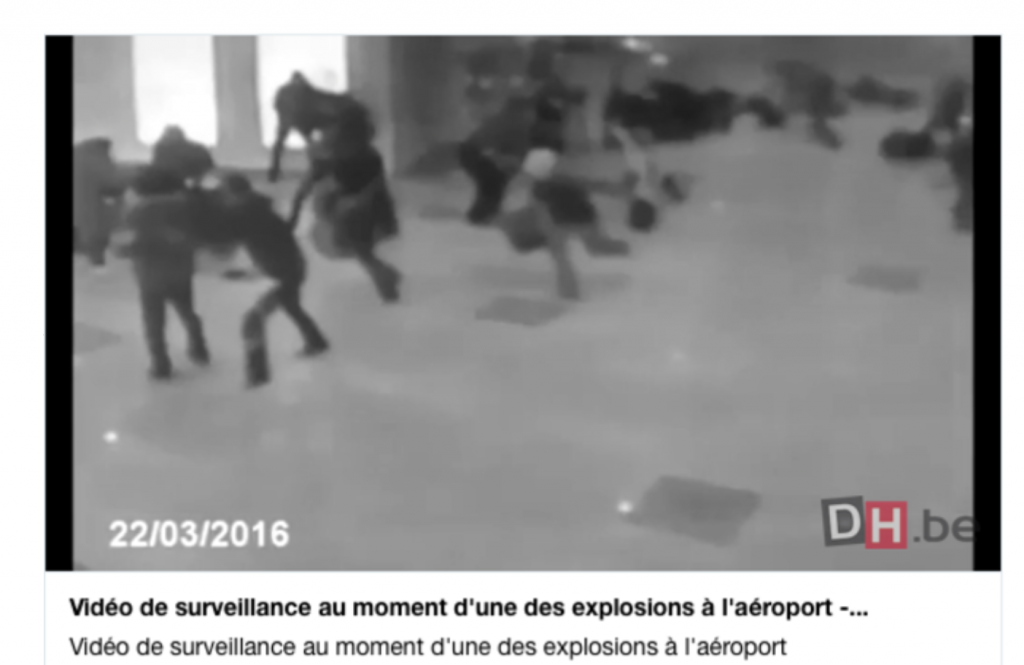
Now compare this to
Moscow airport attacks (January 2011) Video 1 scan (Moscow airport, January 2011)
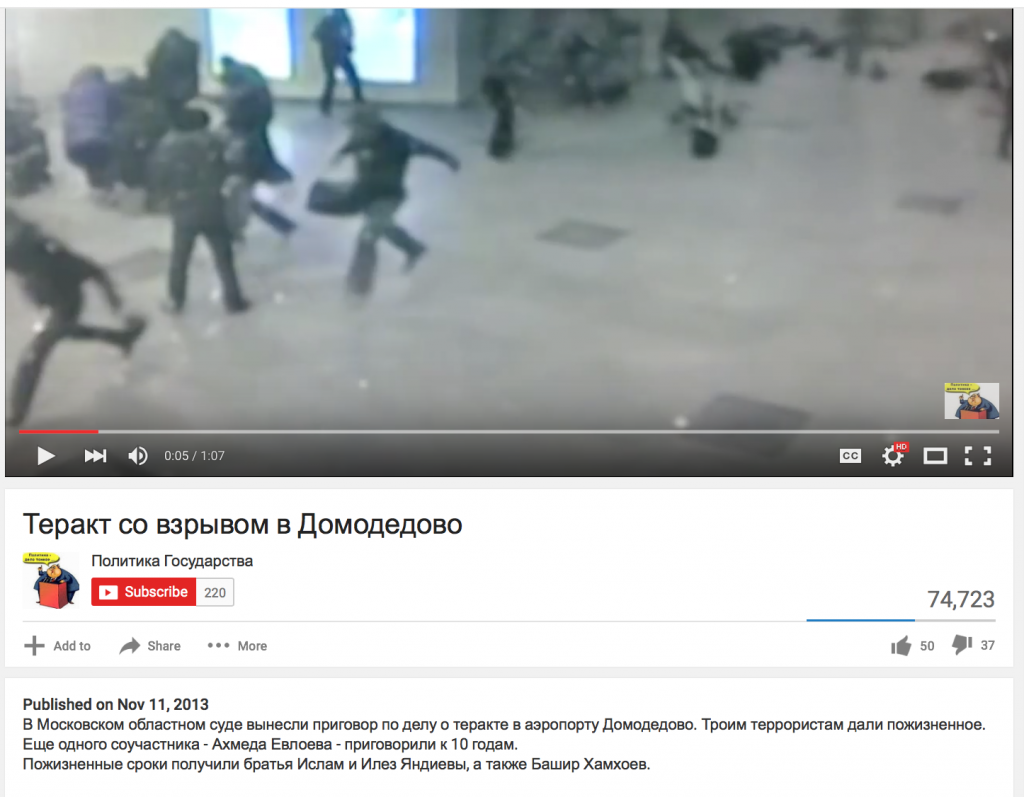
9:10 am: A blast is reported on a train at the Maalbeek metro subway station, near the headquarters of the European Commission.
AGAIN: The video broadcast of the Maalbeek metro explosion was not from the CCTV cameras as reported by the police and the media. It was from the Minsk, Belarus metro bomb blast in April 2011.
(see photo scans at the foot of this article)
What we can conclude is that:
1) Dernière Heure broadcast a video of the Moscow airport bomb attack instead of the Brussels blast (recorded by CCTV camera) airport attack. Was it sloppy journalism or something else? This is a matter for the police to investigate. (The broadcast of the video footage of the Minsk metro attack was equally misleading).
2) The official CCTV airport security video was not available to Dernière Heure at 9.07am and the public was misled by the release of the Moscow video.
One would therefore assume that if the CCTV video footage of the blast had been available to Dernière Heure, they would have broadcast it instead of the Moscow footage.
3) Assuming that the airport CCTV video footage was not available to Dernière Heure at 9.07am, how come they were able to get their hands on still images from the CCTV video surveillance system showing the three alleged terrorists.
10.25am, less than an hour and a half following the release of the “fake” Moscow CCTV surveillance video of the bomb attack (i.e. Moscow) by Dernière Heure, a still image is released by Dernière Heure of the three alleged suspects walking with trolleys in the airport at 7.55am, three minutes before the first blast in the departure terminal.
The image allegedly from an airport CCTV surveillance camera in the departure terminal was released by DH.be at 10.25am, it was tagged EXCLUSIVE, No other media had early access to this alleged airport CCTV video and the still images. The latter were presented with some confusion as photographic evidence pertaining to the identity of the terror suspects.
Most media reports acknowledged that the mysterious photo of the alleged suicide bombers was released by the Brussels police rather than DH.be.
The twitter entries below confirm the exact time at which the airport photos were released:
First Release by DH.be at 10.27am (entitled “Photo Exclusive” by DH.be)
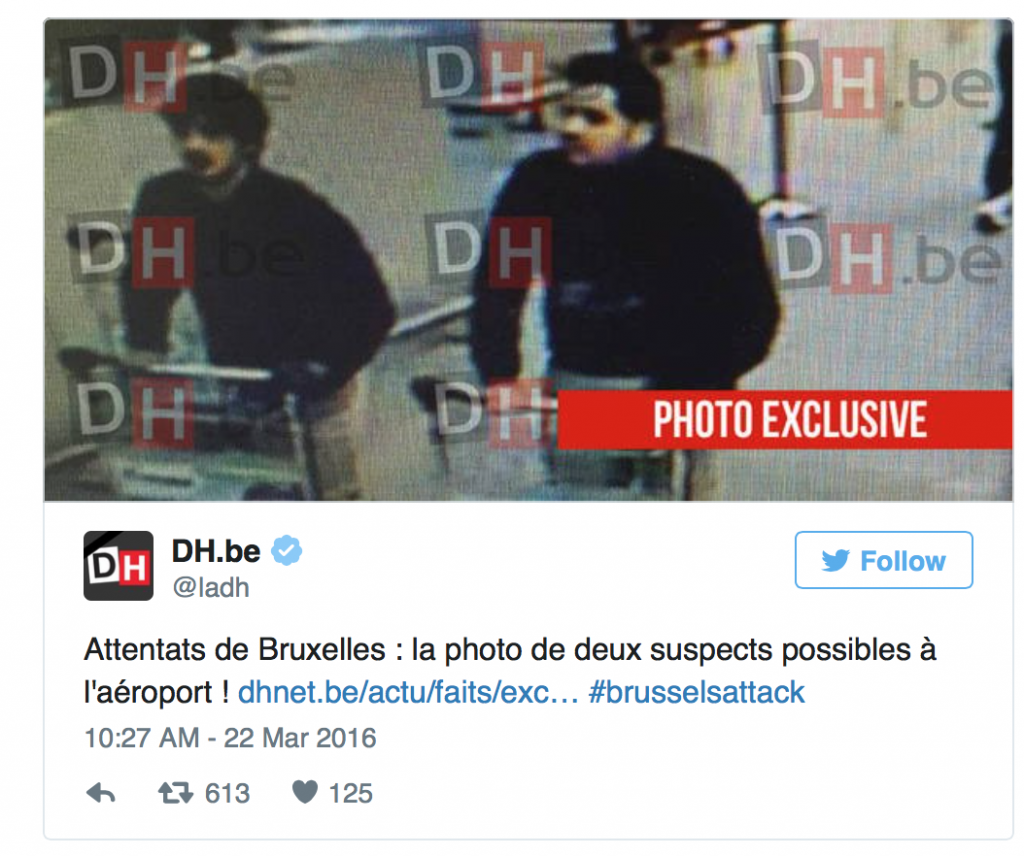
12.58pm, is the time at which the still image is “officially” released by the police in liaison with the office of the prosecutor. (procureur)
Release by Politie Brussel/Police de Bruxelles: 12.58pm

In an unusual twist, it would appear that Dernière Heure had access to the alleged CCTV still images from the surveillance cameras BEFORE the police.
The media reported that the photo was from federal police sources and was provided on the instructions of the federal prosecutor [procureur]:

DH.be released the still image of the three alleged terrorists at 10.25am, two and a half hours before its official release by Brussels police at 12.58pm, which suggests that the exclusive image published by Dernière Heure DID NOT emanate from the police authorities.
There is always the possibility that a police and/or airport surveillance personnel made these still images available to Dernière Heure prior to their official release by Brussels police at 12.58pm. It is also possible that the still images were taken by a CCTV camera which was live streaming and that this video livestream was accessible to the public.
The third possibility is that the Brussels police took cognizance of the photograph which Dernière Heure described as a still image from the CCTV airport surveillance system and decided to release it without verifying its original source.
On April 7, new video footage showing the man in the hat leaving the airport, circa 7.56am-7.57am was made public. The still image of him leaving the airport is stamped 7.54am
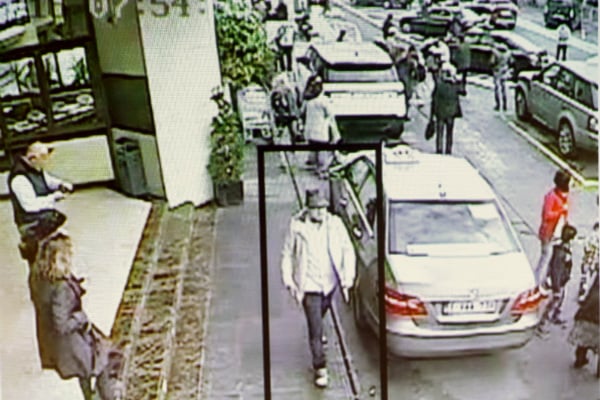
Now let us recap:
DH.be released both the Moscow 2011 video of the bomb attack at 9.07am (instead of the Brussels airport CCTV footage) as well as the still image allegedly from the same CCTV airport source (in the departure terminal) of the three terrorists at 10.25am.
Did DH.be have access to the security CCTV cameras?
At 9.07am, they did not have access to the CCTV video footage. They presented Moscow footage (in lieu of Brussels footage) at 9.07am under the byline: “video de surveillance a l’aeroport”. They then claimed that the still image released at 10.25am was from the same source, namely the CCTV camera system at Brussels airport, departure terminal.
Let us play the devil’s advocate: If DH.be had been in possession of the real surveillance video footage at 9.07am, why on earth would they have released the Moscow airport footage and then one and a half hours later come up with an allegedly authentic image from the CCTV airport cameras.
There is another important caveat. While police and surveillance authorities would be able to view and analyse almost immediately the camera footage of the bomb explosion, the same does not apply to the process of identifying three passengers with trolleys mingling amongst several hundred airline passengers also with trolleys in the departure terminal.
In other words, to identify three individuals from a large number of airport CCTV cameras with hundreds of passengers travelling early morning would not have been an easy fast-track undertaking: the still images pertaining to hundreds of passengers would have had to be examined, compared to police photographic records, etc: An almost impossible task to achieve in a matter of two hours after the blast, assuming that Dernière Heure had access to the CCTV surveillance video data. Normally, journalists would not have had access to the CCTV camera footage prior to the police authorities.
Moreover, the airport was immediately evacuated and closed down at 8.20am, twenty-two minutes after the blast. A state of chaos prevailed. And we are led to believe that the journalists of Dernière Heure managed in collaboration with CCTV camera surveillance personnel and/or police to get hold of the still image of three alleged terrorists, which they released at 10.25am, prior to the conduct of a police investigation and less than two and half hours following the 7.58am bomb blast.
Video 2 scan (Minsk Metro, April 2011)
Here is a screenshot of the Minsk 2011 video footage broadcast on Belgian network TV and on the internet depicting the explosion in the Metro in Brussels, March 22, 2016
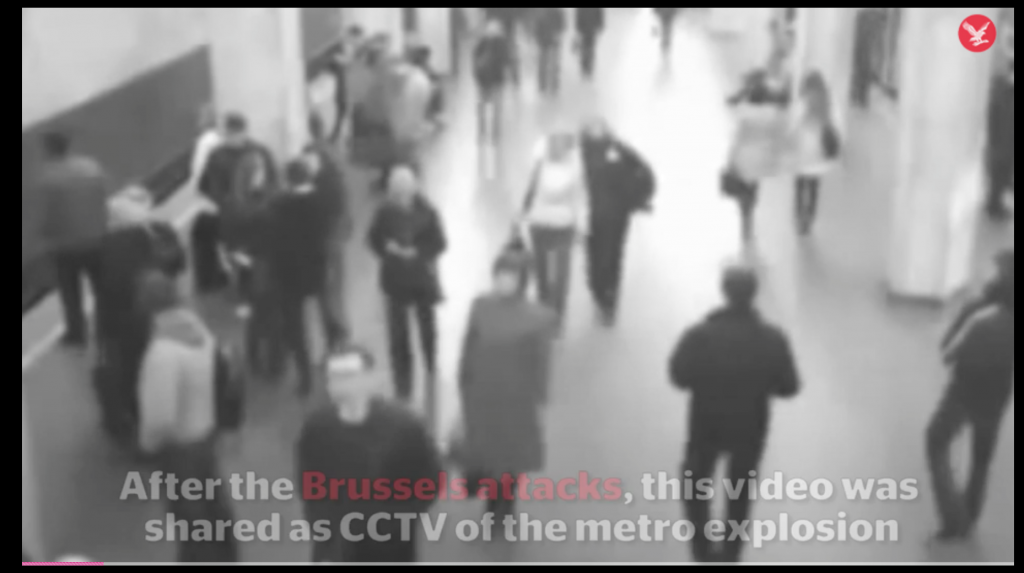
Now Compare the above to the screenshot of the Minsk April 2011 attacks.
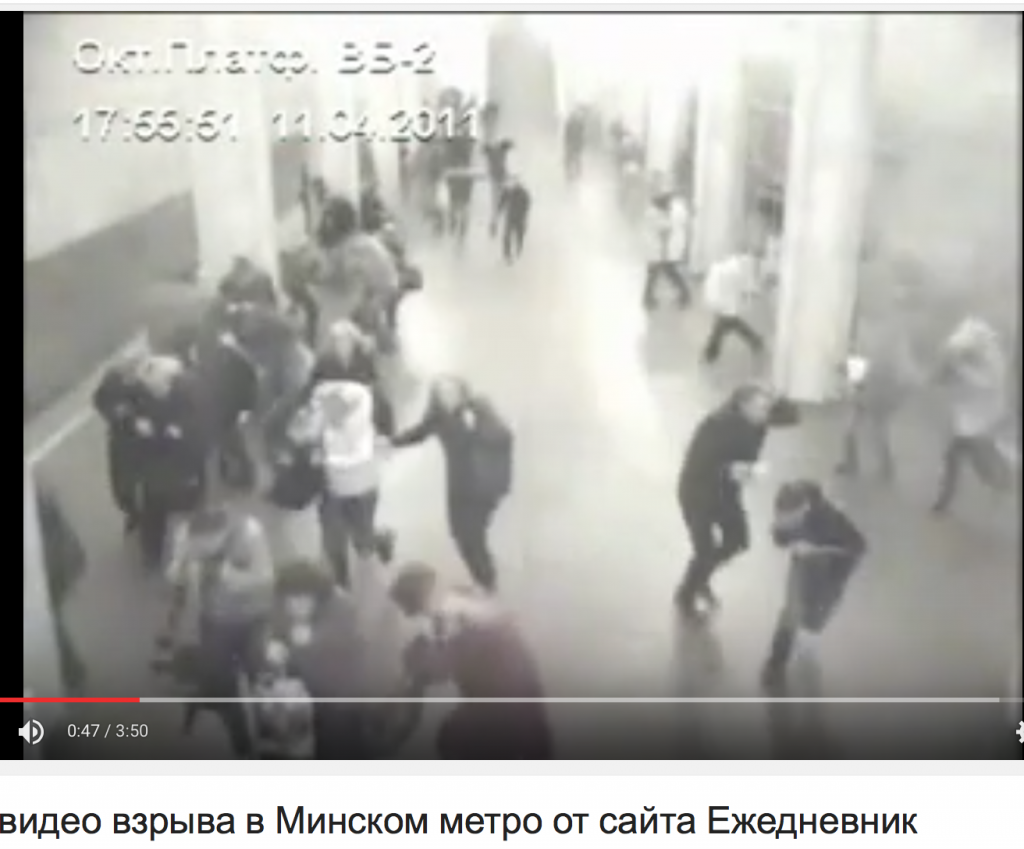
These are the questions for police investigators.
1. Why did Dernière Heure deliberately broadcast at 9.07am the video footage of the January 2011 Moscow airport terror attack?
Why did the media broadcast the video footage of a Minsk, Belarus metro terror attack in 2011 in lieu of the surveillance video of the metro?
In other words both the metro and airport videos were “fake”.
2. Did Dernière Heure interface with Belgian police and intelligence prior to releasing the Moscow airport video which was broadcast Worldwide?
3. Who authorized the release of this fake video?
4. What are the legal implications of this negligence on the part of Dernière Heure?
5. Where did Dernière Heure get the still image from which they released as an EXCLUSIVE at 10.25amprior to the conduct of a police investigation?
6. Was there evidence of them having access to the CCTV cameras? Did the CCTV airport surveillance personnel provide Dernière Heure with access to CCTV footage? Assuming they did, how on earth did the Derniere Heure journalists manage to single out a still image of three passengers, establish and corroborate their identity in the absence of a police investigation and without immediate access to police records.
7. Did the police corroborate the identity of these three individuals prior to 10.25am and communicate the results of their investigation to Dernière Heure?
Highly unlikely: lest we forget, the police released the still image at 12.58am, two and a half hours later. By that time, the EXCLUSIVE picture by Dernière Heure had been picked up by the news chain, it had circled the globe prior to its official release by the Brussels police.
Concluding Remarks
People in Belgium who are living the dramatic aftermath of this national catastrophe and loss of life: Draw your own conclusions. Is your government telling the truth?
The Belgian police, by addressing these seven questions, should be in a position to establish the authenticity and the source of the still pictures of the three men at the airport. Will they undertake this task?